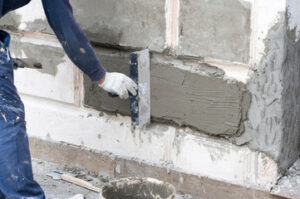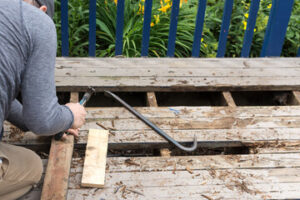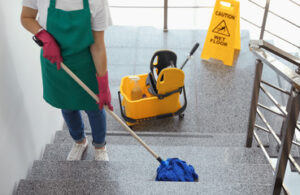The structural damage in concrete structures can be caused by many factors. A qualified inspector can recommend repair methods and materials to correct the damage and prevent future problems.
Some important characteristics of a repair material include low shrinkage (the existing concrete has already gone through its shrinkage) and good bond strength. It must also be chemically compatible with the existing concrete. To learn more, visit https://www.bakersfieldconcretecontractorservices.com.

Surface preparation is one of the most important parts of any concrete repair project. It’s essential to have a clean and uncontaminated surface for coatings, adhesives, welding, and other applications. Contaminants such as dirt, dust, oil, and rust can inhibit the effectiveness of these processes. Advanced surface preparation techniques like abrasive blast cleaning can remove these contaminants from a surface, leaving it ready for the next application.
Surface texture, porosity and the interface between a hardening repair material and the existing concrete substrate are major factors in the durability of concrete repairs [1]. It is therefore very important to select appropriate repair products for concrete with a specific surface quality, e.g. high strength, low permeability and/or low E-modulus.
The surface preparation needed to prepare the concrete for patching varies depending on the type of patching being performed. In general, the damaged area should be thoroughly cleaned and abrasive blast cleaned if necessary. This is to ensure that the new patching material will adhere properly. If the damage is located in an area that isn’t easily accessible, a chemical etch may be required to provide better adhesion.
A common method for repairing concrete is by using polymer-modified cementitious patching compounds. These are mixtures of hydraulic cement and organic binders that form a co-matrix of hydrated cement and polymer film throughout the concrete structure. Polymer-modified patching compounds have shown superior performance in terms of flexural and tensile strength, bond strength, abrasion resistance, water permeability and elastic modulus, compared to conventional hydraulic cement alone.
Other surface preparation methods include flame blasting and water jet cutting. Both of these methods are effective in removing contamination from a surface, but they require special training and equipment. They can be used on a variety of surfaces, including metal and wood. The level of contamination on the surface also impacts the selection of the proper surface preparation method. For example, heavily rusted metal may require an aggressive approach such as abrasive blasting, while lightly contaminated steel may only need a quick wipe down with solvent.
Shotcrete is another form of concrete repair that requires a different type of surface preparation. It is a process of spraying dry or wet concrete onto a surface. Shotcrete can be done on vertical or overhead surfaces and offers superior strength and durability. This type of repair is often used for rehabilitation and conservation projects because it protects the underlying concrete from damage, prevents moisture intrusion, and enhances the aesthetics of the structure.
Repair Materials
Concrete is one of the most widely used materials around the world. While it is durable in a wide range of environmental conditions, its longevity can be compromised by certain exposures and structural stresses such as vibrations, shear and bending forces. For this reason, it is important to repair damaged concrete with the proper materials and under appropriate conditions. There are many different types of concrete repair products on the market. Some are designed and formulated to meet specific needs while others are more generalized in their application. The repair material chosen must be compatible with the existing concrete in terms of its chemical composition, temperature and moisture content, and it should be capable of resisting tensile stress without debonding from the surface of the substrate. In addition, the material must be able to resist any form of energy such as ultraviolet rays and heat or chemical attack.
It is also important that the repair material have a coefficient of thermal expansion similar to that of the existing concrete to prevent undue stresses being transferred to the bonding interface or within the substrate. It should also have a high compressive strength and abrasion resistance to ensure its durability.
Mechanical bonding methods can be utilized to provide good interfacial adhesion between the new repair material and the existing concrete substrate. There are several ways to achieve this, including increasing the roughness of the substrate surface, adding fibers and using interfacial coupling agents.
Generally, the best type of repair material for small non-structural repairs is a concrete patching compound such as QUIKRETE(r) Vinyl Concrete Patcher, which can be troweled to from 1/4 down to a feather edge on a concrete surface and then sanded to create a smooth surface. Another option is Rapid Patch Hairline Crack Repair, a low-viscosity urethane repair product that dries gray and can be hand sanded to a smooth finish.
For more extensive repairs, a concrete patching mortar such as dry pack may be used. This is made by mixing a part cement with two parts sand to create a paste. This can be troweled to the desired thickness and then sanded with a masonry broom to produce a non-slip finish typically found on exterior concrete surfaces.
Repair Procedures
A successful concrete repair depends on a number of factors, including the type of damage and its severity, ability to accomplish the repair correctly, and availability of the necessary materials. The cost of repair versus the cost of replacement should also be weighed as well as the effective lifespan of the repaired structure.
It is vital that the responsible factor for the damage is determined so that the repair can be designed to avoid recurrence of the problem. This will help to minimize maintenance costs in the future. Often, it is best to contact a professional contractor who can provide expert advice and the proper tools and equipment needed for the job.
The preparation of the damaged concrete, choice of repair material, placement of the repairs and adequate curing are important steps in ensuring that the final product is satisfactory. Incompatibilities between the repair material and the host concrete can lead to premature failure of the repair due to differential expansion and shrinkage, as well as interaction stresses at the interface.
Concrete repair should be completed as soon as possible to minimize the impact of differential expansion and shrinkage between the original and repaired concrete. It is also important to ensure that the repairs are properly executed and cured in accordance with the manufacturer’s instructions.
Depending on the extent of the damage and the repairs required, concrete repair can take anywhere from a few hours to several days. It is important to allocate sufficient time to the project so that it can be completed thoroughly and accurately.
A successful repair depends on the ability of the repaired concrete to resist the effects of the service environment, especially the penetration of deleterious chemicals. It should also be capable of preventing further deterioration of adjacent concrete and reinforcement steel.
For example, if the deterioration is caused by chloride contamination, the concrete repair should contain corrosion inhibitors to prevent further chemical degradation of the concrete. It is also important to use proper reinforcement techniques, such as rebar fabrication and installation, to achieve the desired strength.
Maintenance
It is vital that concrete structures are maintained and repaired regularly in order to extend their lifespan and bolster safety. If a problem is left unattended, it can become much more costly to fix.
Concrete repairs may include resurfacing, coatings, painting, and sealing in order to repair surface damage, protect the structure from further degradation, or improve its aesthetic appeal. This is especially important for commercial buildings that rely on the appearance of their concrete to attract and retain customers.
In addition to protecting against structural failures, regular concrete maintenance can also help property owners save money on utility bills. This is because well-maintained concrete surfaces are more energy efficient, which can reduce heating and cooling costs.
If a concrete surface is not properly cared for, it can develop problems such as cracks, spalling, or settlement. These problems are not only unsightly, but they can also cause tripping and slipping hazards. Prompt repair of these issues will prevent them from worsening and allow the concrete to continue to perform as intended.
To maintain concrete, routine inspections should be conducted to identify any signs of deterioration or damage. These inspections should be detailed and thorough in order to identify the source of the deterioration, such as corrosion, moisture penetration, or chemical spills. Regular cleaning and sealing of concrete structures can also extend their lifespan by preventing the build-up of harmful substances that accelerate deterioration.
Aside from extending the life of concrete, prompt repairs can also reduce the cost of maintenance by preventing the need for expensive replacement projects. Replacing existing concrete requires a significant amount of time, effort, and resources, including hiring a contractor, demolition, disposal of the old concrete, and waiting for new concrete to cure.
When searching for a contractor to perform concrete repairs, it is important to find one that has experience in the specific type of project that is being performed. In addition, the contractor should be able to provide a detailed estimate and timeline for the project. Finally, the contractor should be able to offer a warranty and insurance in order to provide peace of mind that the work will be completed properly and safely.





